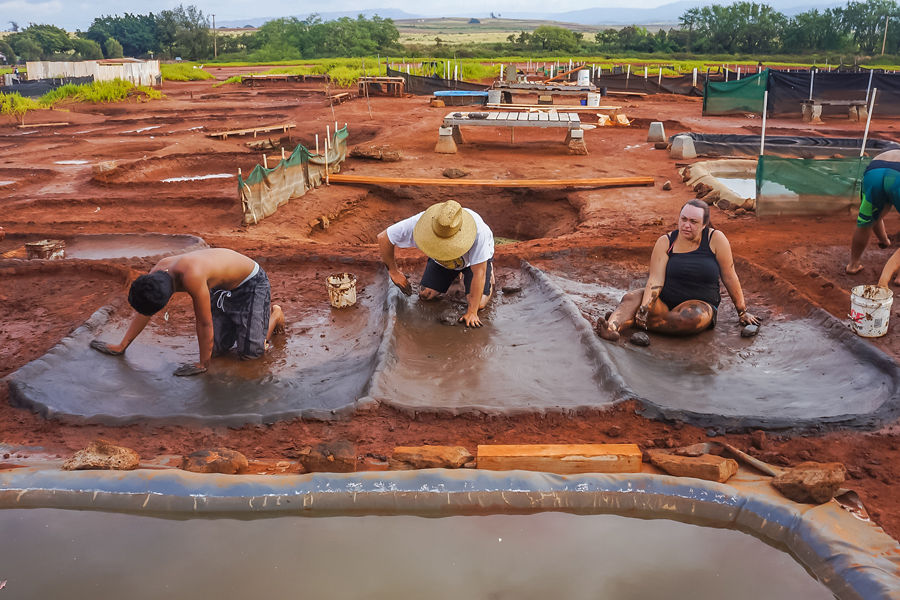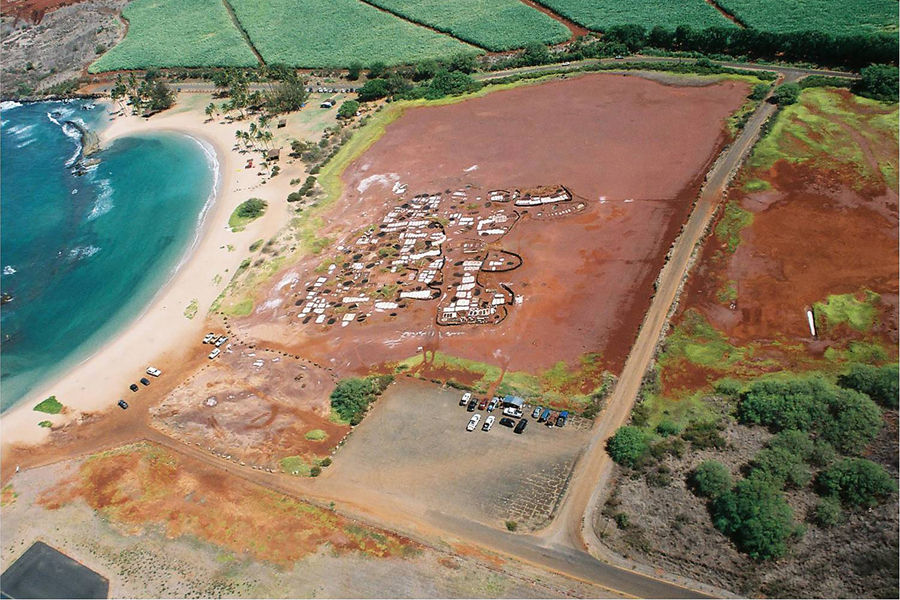“Making salt is part of who I am,” says Kuulei Santos. “Not many people can say, ‘I’m standing in the exact same place my grandmother stood, doing the exact same thing.’ I love to teach children that there is more to their culture than just learning a word or singing a song. It’s hard work and a humbling experience, but we keep doing it because we love our history and paakai is part of that.”
Paakai means “the hardening of the sea,” Santos explained. Hawaiians have been making salt at the Salt Flats near Salt Pond Park in Hanapepe for many generations. As seawater flows through underground lava tunnels, it fills wells inside the Salt Flats, where there are more than 460 rectangular “ponds.”
Santos’s family maintains 14 ponds and has access to two tunnels. Every spring, her family uses dark gray clay they have gathered from the surrounding area to line the bottom of the beds, allowing seawater to evaporate instead of being absorbed into the ground. Come late September, three types of flaky salt are harvested. The top layer produces white crystals, the middle layer produces pale pink crystals and the bottom layer is light gray. Sometimes the salt is mixed with alae, a red clay from Kokee. As tradition has established, the salt cannot be sold. It is only given as a gift.
Last October, Slow Food Oahu invited Santos to speak at Terra Madre and Salone del Gusto in Turin, Italy. Individuals from all over the world, who are passionate about good, clean and fair food, made the pilgrimage to be a part of the world’s largest food and wine fair. For 12 days, Santos let people taste Hanapepe Sea Salt while sharing her story.
“It was an eye-opening experience,” she recalls. “I learned there’s a difference between organic chicken and regular chicken. Organic tastes better, for one! I never thought about how food gets to my table, or how many miles it has traveled. The markets were overflowing with very fresh, affordable produce, meat and fish. You can’t get that here.”
Even though the Salt Flats are listed on the State Register of Historic Places, Santos feels powerless as she watches a number of factors in the neighboring area disregard this culturally significant site. As Hanapepe Sea Salt becomes harder to make, the treasured legacy becomes even more rare.
No physical structures protect the area, which make the Salt Flats’ clay vulnerable to broken glass, trash and sand. Feral cats roam the area and when people drive on the beach, a sand berm is compressed, allowing the tide to flush the ponds. Old asphalt was dumped on the drainage area, which limits the amount of water that can reach the beds. Santos says that in 2011, the county earmarked $90,000 to remove the asphalt, but as of today, the asphalt is still there.
Earlier this year, Dow AgroSciences offered to pay for improvements of the bathrooms located at Salt Pond Beach Park. The plan was to clean and paint the restrooms. Santos had found a local artist who made sketches with high school kids, and they were going to paint murals on the bathrooms as well.
“I didn’t do it because I got a lot of hate mail from the anti-GMO people,” says Santos, who is reconsidering her decision. “It’s horrible down there and it’s important to it clean up. If it looks ghetto, it’s going to be treated ghetto. But if it looks nice, people will do a better job of taking care of it.
“When I was in Turin, I met so many people doing a lot of great things,” she says. “I learned that we are all facing the same types of battles. It takes a community to protect a part of our history, a part of our culture. It is not just Kauai people; our salt goes around the world.
“I met a couple that are poi farmers on Oahu,” she continues. “They don’t have electricity. They can’t afford to eat out. But they work hard so the rest of us can eat poi. People don’t understand that. It’s the same with salt. If every single person who asked me for Hawaiian salt, first asked me ‘What can I do to help?’ we would be in a way better spot than we are today.”
Santos says everyone can help by catching a cat and dropping it off at the Humane Society, or walking around the salt patch and picking up trash. Donations are welcome and she is in the process of creating a nonprofit organization. For more information, visit paakai.com or like “Protecting Paakai Farming at Salt Pond, Hanapepe” on Facebook.
Marta Lane, a Kauai-based food writer since 2010, offers food tours and is the author of “Tasting Kauai: Restaurants — An Insider’s Guide to Eating Well on the Garden Island.” For more information, visit TastingKauai.com.







